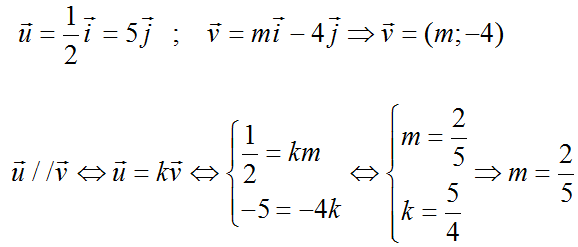Hãy nhập câu hỏi của bạn vào đây, nếu là tài khoản VIP, bạn sẽ được ưu tiên trả lời.

Ta có: \(\overrightarrow{u}=\left(\dfrac{1}{2};-5\right)\) ; \(\overrightarrow{v}=\left(k;-4\right)\)
Để hai vectơ \(\overrightarrow{u}\) và \(\overrightarrow{v}\) cùng phương
\(\Leftrightarrow\dfrac{k}{\dfrac{1}{2}}=\dfrac{4}{5}\Leftrightarrow k=\dfrac{2}{5}\)

Có \(\overrightarrow{u}=\left(2;-1\right);\overrightarrow{v}=\left(1;x\right)\)
\(\overrightarrow{u}\) cùng phg vs \(\overrightarrow{v}\)
\(\Leftrightarrow\frac{1}{2}=\frac{-x}{1}\Leftrightarrow x=-\frac{1}{2}\)

Câu 1:
Theo tính chất trọng tâm và đường trung tuyến, ta thấy \(\overrightarrow {AM}; \overrightarrow{GM}\) là 2 vecto cùng phương, cùng hướng và \(AM=3GM\)
\(\Rightarrow \overrightarrow{AM}=3\overrightarrow{GM}\)
\(=\frac{3}{2}(\overrightarrow{GM}+\overrightarrow{GM})\) \(=\frac{3}{2}(\overrightarrow{GB}+\overrightarrow{BM}+\overrightarrow{GC}+\overrightarrow{CM})\)
\(=\frac{3}{2}[(\overrightarrow{GB}+\overrightarrow{GC})+(\overrightarrow{BM}+\overrightarrow{CM})]\)
\(=\frac{3}{2}(\overrightarrow{GB}+\overrightarrow{GC})\) (vecto \(\overrightarrow{BM}; \overrightarrow{CM}\) là 2 vecto đối nhau nên tổng bằng vecto $0$)
Đáp án B
Câu 2:
\(\overrightarrow{u}=\overrightarrow{AB}+\overrightarrow{DC}+\overrightarrow{BD}+\overrightarrow{CA}\)
\(=(\overrightarrow{AB}+\overrightarrow{BD})+(\overrightarrow{DC}+\overrightarrow{CA})=\overrightarrow{AD}+\overrightarrow{DA}\)
\(=\overrightarrow{0}\) (tổng của 2 vecto đối nhau)
Đáp án C
Câu 3:
Bạn nhớ rằng \(\overrightarrow{a}; k\overrightarrow{a}(k\in\mathbb{R})\) luôn là 2 vecto cùng phương (tính chất vecto). Nhưng nó mới chỉ là cùng phương thôi. Muốn cùng phương +cùng hướng thì \(k>0\) ; muốn cùng phương + ngược hướng thì \(k< 0\). Nói chung là phụ thuộc vào tính chất của $k$
Câu C thì hiển nhiên sai.
Nên đáp án B đúng

a) \(\overrightarrow{a}\left(2;3\right)\);
b) \(\overrightarrow{b}\left(\dfrac{1}{3};-5\right)\);
c) \(\overrightarrow{c}\left(3;0\right)\);
d) \(\overrightarrow{d}\left(0;-2\right)\).

\(\overrightarrow{u}=\left(\dfrac{1}{2};-5\right);\overrightarrow{v}=\left(k;-4\right)\)
để vecto u vuông góc với vecto v thì 1/2*k+(-4)*(-5)=0
=>k*1/2=-20
=>k=-40